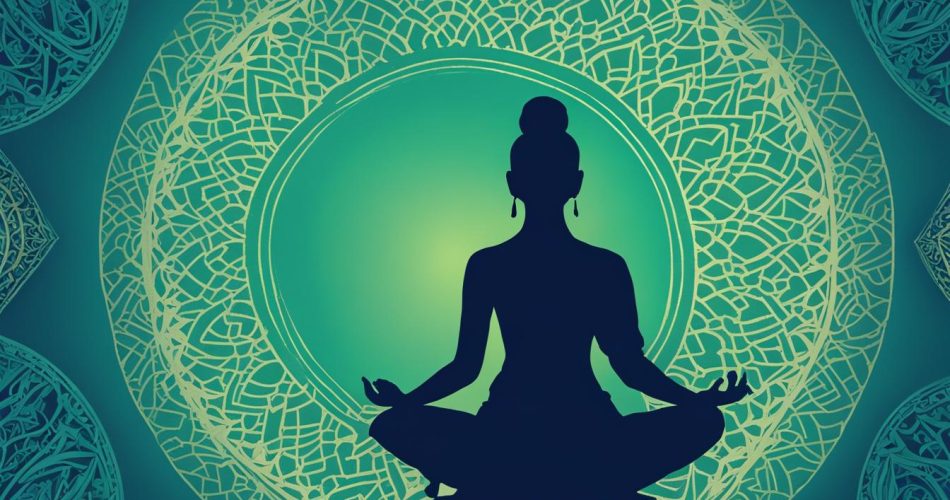Many relaxation techniques can help reduce the damaging effects of stress and promote relaxation and calm. It is essential to find the technique that suits your lifestyle and resonates with you. This article explores eight different meditation techniques for relaxation and stress relief, including progressive muscle relaxation, deep breathing, visualization, body scan meditation, mindfulness meditation, self-massage, yoga, and mindful exercises.
Key Takeaways:
- Discover various meditation techniques for relaxation and stress relief.
- Explore progressive muscle relaxation and how it can help release muscular tension.
- Learn the power of deep breathing exercises for promoting relaxation.
- Find out how visualization techniques can transport you to a peaceful state of mind.
- Experience the benefits of body scan meditation for mindfulness and body awareness.
Progressive Muscle Relaxation
Stress can take a toll on both our minds and bodies, leading to muscle tension and discomfort. This is where progressive muscle relaxation comes to the rescue. By systematically tensing and relaxing different muscle groups in your body, you can release built-up tension and experience deep relaxation.
Progressive muscle relaxation involves a series of steps where you intentionally tighten and then release different muscle groups. This technique not only helps you become more aware of your bodily sensations but also promotes a sense of calm and relief from stress.
To practice progressive muscle relaxation, find a quiet and comfortable space where you can fully relax without any distractions. Begin by taking a few deep breaths to center yourself. Start with your toes, tensing them for a few seconds before releasing the tension and allowing them to relax completely. Move up your body, focusing on different muscle groups such as your calves, thighs, buttocks, abdomen, chest, arms, hands, neck, and face.
The regular practice of progressive muscle relaxation can teach your body to let go of tension and promote a state of deep relaxation. By incorporating this technique into your daily routine, you can experience improved overall well-being.
An effective way to enhance the benefits of progressive muscle relaxation is to combine it with deep breathing exercises. Deep breathing helps activate the body’s relaxation response, further reducing stress levels and promoting a sense of calm.
Engaging in progressive muscle relaxation and deep breathing exercises regularly can provide you with a powerful tool to combat stress and promote relaxation. Incorporate these techniques into your daily routine to experience the profound benefits they offer.
Progressive Muscle Relaxation Technique
| Steps in Progressive Muscle Relaxation |
|---|
| 1. Find a quiet and comfortable space. |
| 2. Take a few deep breaths and center yourself. |
| 3. Start with your toes, tensing them for a few seconds and then releasing. |
| 4. Move up your body, focusing on each muscle group, tensing and relaxing them. |
| 5. Take deep breaths throughout the process to enhance relaxation. |
| 6. Practice regularly for maximum stress relief. |
Deep Breathing
When it comes to finding quick and effective relaxation techniques, deep breathing exercises are hard to beat. The best part? You can do them anywhere, anytime, whenever you feel the need to unwind and calm your mind. Deep breathing exercises offer a simple yet powerful way to lower your stress levels and promote relaxation.
How does deep breathing work?
By focusing on your breath and taking slow, deep breaths in through your nose and out through your mouth, you activate your body’s parasympathetic nervous system—the part responsible for the “rest and digest” response. This triggers a relaxation response, helping you feel more calm and at ease.
“Deep breathing is like a natural tranquilizer for your mind and body.”
Not only do deep breathing exercises help reduce stress, but they also have several other benefits. They can improve your focus, increase your energy levels, and enhance your overall well-being. By incorporating deep breathing into your daily routine, you can experience a greater sense of calm and balance.
Enhancing the benefits of deep breathing
Deep breathing can be combined with other relaxation practices to amplify its effects. For example, playing soft, soothing music or using aromatherapy oils can create a more serene environment and enhance your relaxation experience.
Are you ready to try deep breathing?
Let’s get started with a simple deep breathing exercise:
- Find a comfortable position, either sitting or lying down. Close your eyes or maintain a soft gaze.
- Place one hand on your abdomen, just below your ribs, and the other hand on your chest.
- Take a slow, deep breath in through your nose, allowing your abdomen to rise as you fill your lungs with air. Feel your hand on your abdomen rise.
- Exhale slowly through your mouth, emptying your lungs. Feel your hand on your abdomen lower.
- Continue this deep breathing pattern, focusing on the sensation of your breath flowing in and out.
- Practice deep breathing for a few minutes, gradually increasing the duration as you become more comfortable.
Remember, deep breathing is a skill that improves with practice. You can use this technique whenever you need a moment of calm or as part of a regular relaxation routine.
| Benefits of Deep Breathing Exercises | How to Practice Deep Breathing |
|---|---|
| 1. Reduces stress levels | 1. Find a comfortable position |
| 2. Promotes relaxation and calm | 2. Place one hand on your abdomen, the other on your chest |
| 3. Enhances focus and concentration | 3. Inhale slowly through your nose, feel your abdomen rise |
| 4. Boosts energy levels | 4. Exhale slowly through your mouth, feel your abdomen lower |
| 5. Improves overall well-being | 5. Repeat the deep breathing pattern for a few minutes |
Give deep breathing exercises a try and experience the profound impact they can have on your well-being. Start incorporating this simple technique into your daily routine and enjoy a greater sense of calm, relaxation, and stress relief.
Visualization

Visualization, also known as guided imagery, is a powerful technique for relaxation and stress relief. It involves creating a mental image of a peaceful and calming scene or situation. By immersing yourself in this visualization and engaging all your senses, you can let go of anxiety and tension, promoting a sense of inner peace.
To practice visualization, find a quiet and restful place where you won’t be disturbed. Close your eyes and take a few deep breaths to relax your body and mind. Then, imagine yourself in a serene setting. It could be a beach at sunset, a lush forest, or a cozy cabin by a crackling fire. Picture the details as vividly as possible.
As you visualize this scene, pay attention to the sights, sounds, smells, and even physical sensations associated with it. Notice the gentle breeze on your skin, the sound of waves crashing, or the warmth of the fire. Allow yourself to fully experience the relaxation and tranquility of the imagined environment.
“Visualization helps me escape from the stress of everyday life. It’s like taking a mini-vacation in my mind. I can feel my worries melting away as I visualize myself in a peaceful place.”
There are various ways to enhance your visualization practice. You can use soothing music or nature sounds to create a calming ambiance. Guided visualization apps or recordings can provide prompts and guidance for your visualizations. Some people also find it helpful to incorporate affirmations or positive statements into their practice to further enhance relaxation and boost mood.
Regular practice of visualization can bring about a deep sense of calm and relaxation. As you become more proficient, you can use this technique to manage stress in different situations, such as before a challenging meeting or as a bedtime routine for improved sleep.
The Benefits of Visualization:
Visualization has several benefits for relaxation and stress relief:
- Reduces anxiety and stress levels
- Promotes a sense of calm and peace
- Enhances mental focus and clarity
- Improves mood and overall well-being
- Boosts self-confidence and resilience
By incorporating visualization into your daily routine, you can harness the power of your imagination to find inner balance and serenity.
| Technique | Description |
|---|---|
| Visualization | Create a mental image of a peaceful scene or situation to promote relaxation and stress relief. |
| Progressive Muscle Relaxation | Tense and relax different muscles to release muscular tension associated with stress. |
| Deep Breathing | Take slow, deep breaths to lower stress levels and promote relaxation. |
| Body Scan Meditation | Focus on different body parts to promote mindfulness, relaxation, and body awareness. |
| Mindfulness Meditation | Cultivate a state of heightened awareness and let go of thoughts about the past or future. |
| Yoga and Mindful Exercise | Combine movement, breathing, and meditation to promote relaxation, flexibility, and strength. |
In the next section, we’ll explore the benefits and practice of body scan meditation, another effective technique for relaxation and stress relief.
Body Scan Meditation

When it comes to relaxation techniques and stress relief, body scan meditation offers a powerful and effective approach. By focusing your attention on different parts of your body and observing the sensations without judgment, you can promote mindfulness, relaxation, and body awareness.
During a body scan meditation, you start from the top of your head and systematically move your attention down to your toes, paying attention to each body part along the way. This practice encourages you to fully experience the physical sensations without labeling them as good or bad.
As you progress through each body part, you may notice areas of tension, discomfort, or relaxation. The key is to acknowledge these sensations without judgment and allow yourself to let go of any tension or stress you may be holding.
Body scan meditation can be practiced anywhere, whether sitting or lying down. It’s an excellent technique to incorporate into your daily routine, especially before bed or during moments of high stress.
After completing a body scan meditation, take a few moments to relax further, allowing yourself to fully experience the state of relaxation and note how your body feels. This practice cultivates a sense of calm and helps you develop a greater connection between your mind and body.
The Benefits of Body Scan Meditation
Body scan meditation offers numerous benefits for both your physical and mental well-being:
- Promotes relaxation and stress relief
- Increases body awareness
- Enhances mindfulness
- Reduces muscle tension
- Improves sleep quality
- Helps manage chronic pain
With regular practice, body scan meditation can help you become more attuned to your body’s needs, resulting in a greater sense of calm and overall well-being. So why not give it a try and experience the benefits for yourself?
| Benefits of Body Scan Meditation |
|---|
| Promotes relaxation and stress relief |
| Increases body awareness |
| Enhances mindfulness |
| Reduces muscle tension |
| Improves sleep quality |
| Helps manage chronic pain |
Mindfulness Meditation
Mindfulness meditation is a powerful relaxation technique that can help you find peace and balance in the present moment. By focusing your attention on the here and now, you can let go of worries about the past or future, reducing stress, anxiety, and depression.
During mindfulness meditation, you simply observe your thoughts, feelings, and sensations without judgment. You acknowledge them and let them pass without getting caught up in them. This practice cultivates a state of heightened awareness and helps you develop a non-reactive and compassionate approach to your inner experiences.
Mindfulness meditation can be practiced in many different ways and settings. You can set aside dedicated time for formal meditation sessions, finding a quiet and comfortable space where you can sit or lie down. Alternatively, you can incorporate mindfulness into your daily activities like walking, exercising, or even eating. The key is to engage fully in the present moment, focusing on your senses and the sensations in your body.
Through regular practice of mindfulness meditation, you can improve your ability to manage stress and cultivate a sense of inner calm. Studies have shown that mindfulness meditation can reduce anxiety and depression, improve attention and focus, and increase overall well-being.
“Mindfulness isn’t difficult, we just need to remember to do it.”
The Benefits of Mindfulness Meditation
Mindfulness meditation offers a range of benefits for both your mental and physical well-being:
- Reduces stress and anxiety
- Enhances emotional well-being
- Improves focus and concentration
- Fosters self-awareness and self-acceptance
- Promotes better sleep
- Strengthens resilience
Getting Started with Mindfulness Meditation
If you’re new to mindfulness meditation, here are some steps to help you get started:
- Find a quiet and comfortable space where you won’t be disturbed.
- Sit or lie down in a relaxed position, ensuring your body feels supported.
- Close your eyes or lower your gaze, whatever feels most comfortable.
- Take a few deep breaths, allowing yourself to settle into the present moment.
- Direct your attention to your breath, feeling the sensation of each inhale and exhale.
- As thoughts or sensations arise, simply observe them without judgment and gently bring your focus back to your breath.
- Continue this practice for a few minutes or as long as feels comfortable for you.
- When you’re ready, slowly bring your attention back to your surroundings and open your eyes.
Remember that mindfulness meditation is a skill that develops over time with practice. Be patient with yourself and approach each session with an open and curious attitude. With consistency and dedication, you can harness the power of mindfulness meditation to find peace and relaxation in your daily life.
Yoga and Mindful Exercise
Yoga is a powerful practice that combines movement, breathing, and meditation to promote relaxation, flexibility, strength, and balance. Whether you’re a beginner or an experienced practitioner, there are different types of yoga, such as hatha yoga, Satyananda, and power yoga, that you can explore to suit your specific needs and preferences. With regular practice, yoga can help you rejuvenate your body and mind, release tension, and find inner peace.
In addition to yoga, incorporating mindful exercises into your routine can also contribute to relaxation and stress relief. Mindful exercises like walking, running, dancing, swimming, and climbing can help you connect with your body, focus on the present moment, and find a sense of flow and rhythm. These activities not only provide physical benefits but also allow you to engage in mindful movement, redirect your thoughts, and let go of stress and worries.
Whether you choose yoga or mindful exercises, both offer an opportunity to escape the hustle and bustle of daily life and create a peaceful and harmonious space within yourself. By dedicating time to these practices, you can nourish your body, calm your mind, and promote overall well-being. So, embrace the power of yoga and mindful exercise to find balance, reduce stress, and embark on a journey of self-discovery and relaxation.
FAQ
What is progressive muscle relaxation?
Progressive muscle relaxation is a technique that involves systematically tensing and relaxing different muscles in the body. It helps recognize and release muscular tension associated with stress.
How can deep breathing exercises help with relaxation?
Deep breathing exercises involve focusing on your breath and taking slow, deep breaths in through your nose and out through your mouth. They can lower stress levels and promote relaxation.
What is visualization and how does it promote relaxation?
Visualization, or guided imagery, involves creating a mental image of a peaceful and relaxing scene or situation. By immersing yourself in this visualization, you can let go of anxiety and tension.
What is body scan meditation and what are its benefits?
Body scan meditation involves focusing your attention on different parts of your body and observing how each part feels. It promotes mindfulness, relaxation, and body awareness.
What is mindfulness meditation and how does it reduce stress?
Mindfulness meditation involves focusing on the present moment and letting go of thoughts about the past or future. It can reduce stress, anxiety, and depression by cultivating a state of heightened awareness.
How does yoga and mindful exercise promote relaxation?
Yoga combines movement, breathing, and meditation to promote relaxation, flexibility, strength, and balance. Mindful exercises like walking, running, dancing, swimming, and climbing can also help you relax and find a sense of flow and rhythm.

